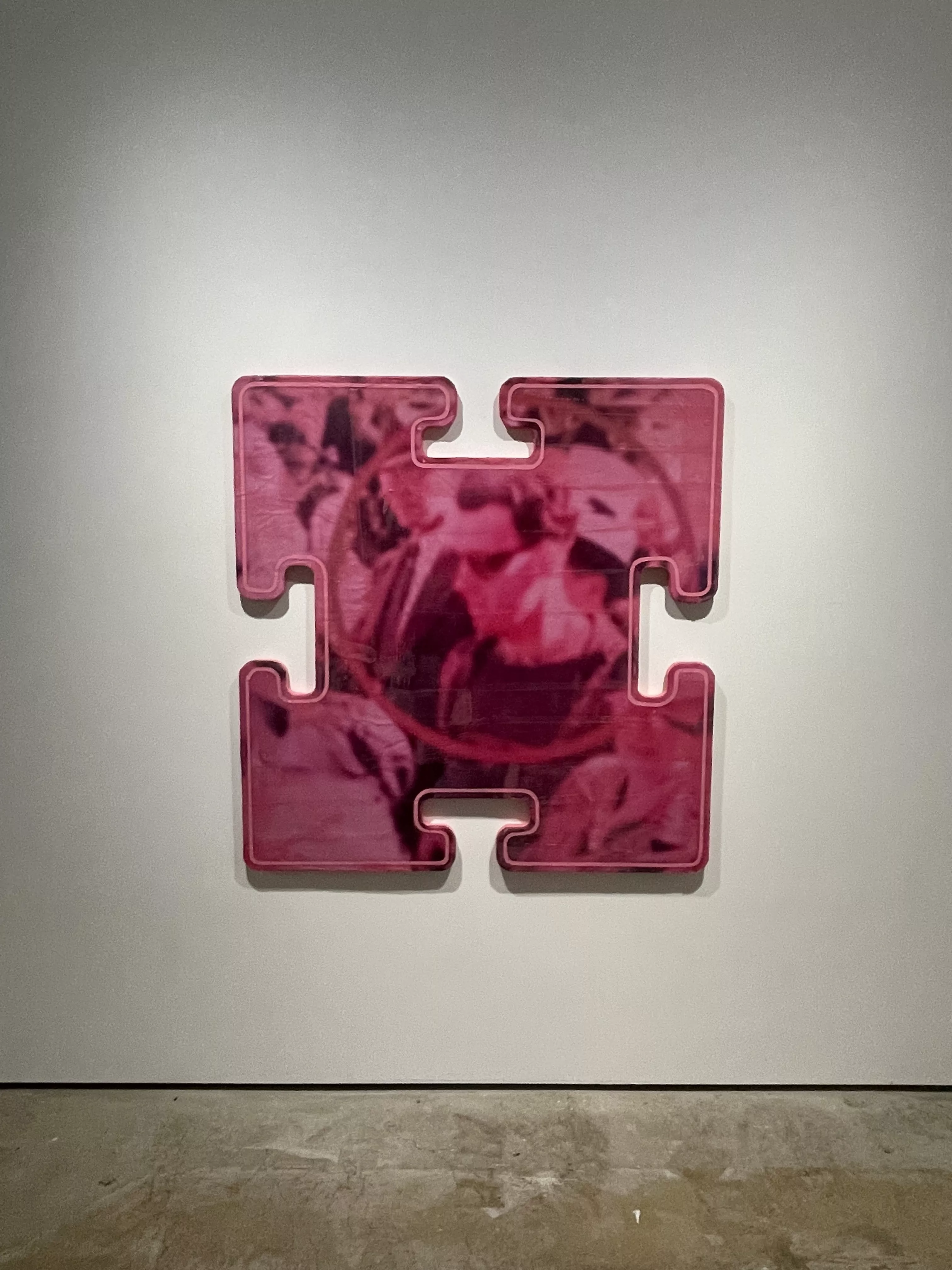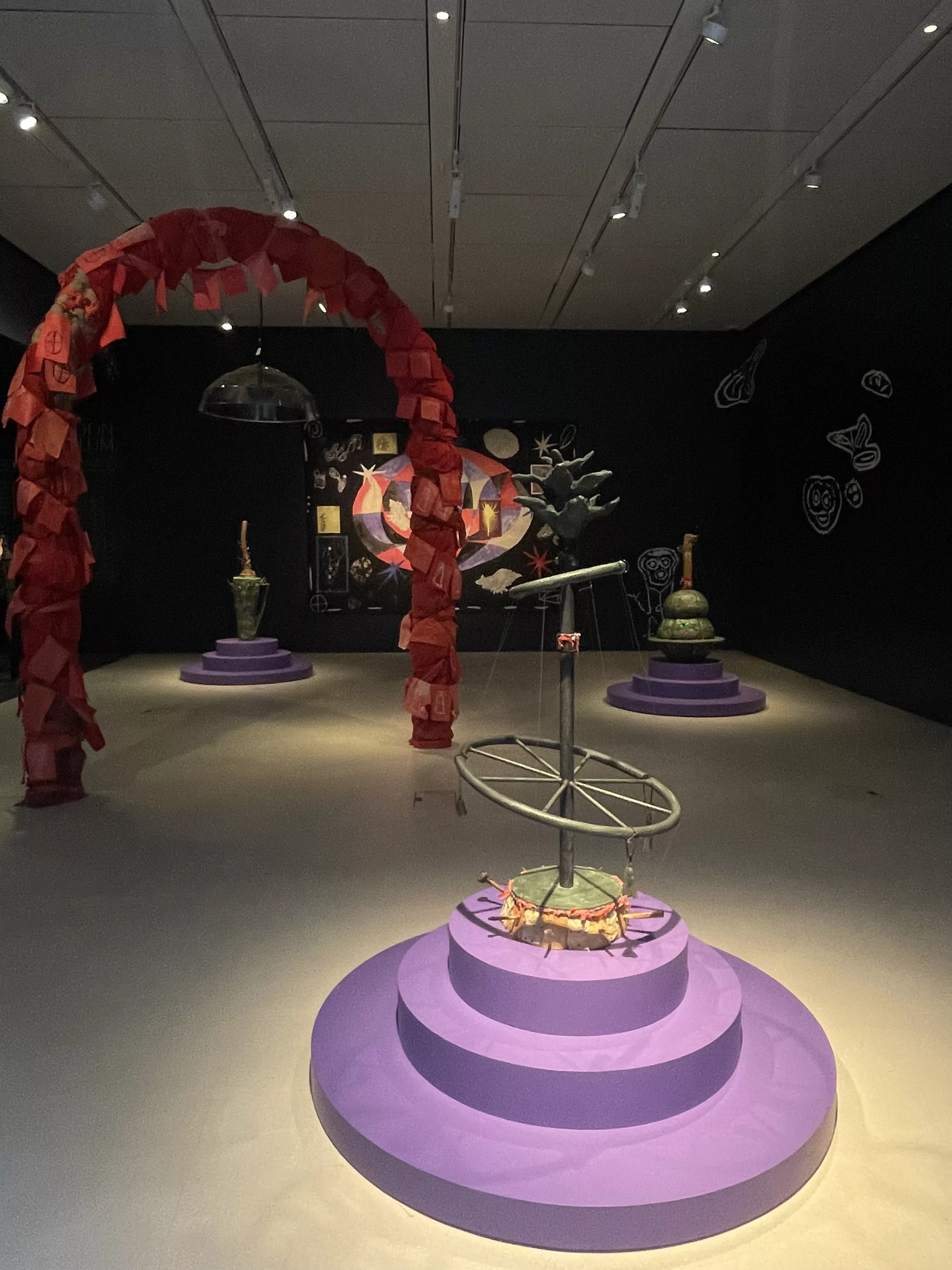In her column the ‘Critic About Town,’ Zarina Muhammad of ‘The White Pube’ tries to make sense of what doesn’t make sense in the world, namely through a tour of a few gallery exhibitions on view in London.

Welcome back to Critic About Town, a column where I write about exhibitions in London and try to make sense of some art and culture in this big bonkers city. I am Zarina Muhammad—a Critic, a Londoner, and someone who bravely attempts to UNDERSTAND things. So I’m qualified for the job, thank you very much.
But it’s still very funny of me to write a whole column about making sense of things, because things haven’t felt sensible since at least 2019. Maybe even 2015. Politics doesn’t make sense, neither does the economy, and we are riding the wave of recession after recession and crisis after crisis (cost of living, housing, climate, energy, etcetera etcetera to infinity). There’s no sense on a macro planetary or institutional scale. Everything is metaphorically and also literally on fire, there’s an election, people are dying in Gaza and when the soon-to-be-ex-Prime-Minister goes on telly he just yells ‘TWO THOUSAND POUNDS!!!’ —a non-sequitur political defense against his party’s fourteen years of spite, violence and managed decline. Excuse me for referencing the political. I wish I wouldn’t, but nothing makes sense! Global events play out on my phone and they feel very distant and abstract, a complete mystery until I feel them tangibly and materially at the Tesco self-checkout. A mystery! I am forced to constantly remember that the world is much bigger than me and completely out of my control.
In this era of senseless confusion, a desire to make sense of things feels like magical thinking. A kind of horror or cosmic fantasy. I cannot sit with the mystery, so I have been thinking earthy-crunchy-woo-woo-crystal thoughts. The not-knowing leaves gaps, so what about the semiotics of whatever is spirited up to fill those gaps? When we make meaning, where does it come from and what actually is it?

Tucked into a side road off Regent Street, Gathering has a little project space in their back room where they host early career artists. It’s called Glasshouse, they typically have more experimental, interesting work in there, alongside the main exhibitions. Last month they were showing Nina Hartmann’s Experience Machine. Sculptures made up of weird, angular geometries. Two triangles stuck to each other in a stretched out star. Arrows coming out the top, side and bottom, like insect legs. Or three pointy headed arrows stretching out like a triangle. Or four arrow heads making a cutout square. Flat and plastic (forest green, translucent baby pink, white with red lining), they speak in the language of signs—on purpose. Jarg road signs at a glance, populated with photos and text, little arrows connecting them all up in a flow chart diagram. Warren Report > two bullets > Jackie Kennedy? 1 > 2 > 3 > 4 > Reality Construction For Calculated Corruption For Reality (round and round like this). A green illuminati cube flips on a lime green prism > clasped hands > symbol.
The press release cycles through mysteries: arcane histories, clandestine narratives, internet conspiracy archives, government databases where fact is stranger than fiction, paranoid networks and Lacan’s diagrams of the subconscious. Arrows indicate the direction of energetic flows, ‘immaterial networks of fear,’ power, and internal logics that operate just under the visible surface. The arrows link it all up into a web of things. Stuff that’s loosely bound, connected by proximity or likeness, feelings, vibes. It’s abstraction — idea and thought being reduced down into symbol, sign, concept (rather than image or form being reduced to colour, line, shape). It’s like that TikTok sound of garbled phonetics, meant to simulate what German sounds like to non-German speakers. It’s simulating! Abstraction, simulating the feeling of someone connecting the dots and making sense of some deep conspiracy web, accessing higher knowledge and understanding of the forces that shape the world and our lives. Although I want to be cynical (wake up sheeple, real eyes realise real lies!) there’s also a part of me that empathises with the impulse. When the world and its institutions move in such mysterious ways, the human imagination dreams up connections that make the lack of sense make sense. Nina Hartmann just picks up the visual language of that sense making.

Slap bang in the middle of that City Boy Bermuda Triangle between Mansion House, Cannon Street and Bank. Where all the lads wear white shirts, padded gilets and quarter zip fleeces. Down on the dried up banks of one of London’s ancient lost rivers, there’s the London Mithraeum. It’s an Ancient Roman Temple to the god Mithras, discovered in the 1950s, archaeologists date it back to the 3rd Century AD. Apparently Mithraeums were typically built under existing buildings, a Mithraeum was found under the Basilica di San Clemente in Rome. They were clandestine, secret spaces. The Cult of Mithras was a mystery religion, knowledge was preserved for participants, and participants would have to be initiated in. It’s where the English word MYSTERY actually comes from, etymology that makes it the ultimate literal mystery. It’s a Bronze Age religion, a secret mystery cult, of course we don’t know much about it. All we have is what’s left: sculptures and objects. Mithras killing a sacred bull, Mithras being born from a rock, a naked lion-headed man with a snake wrapped around his body. We don’t know what any of these images mean! Then everyday objects: shards of pottery, animal bones, amber carved amulets, pins, brooches, coins. The rest is a… well, a mystery.
The London Mithraeum is open as a mini-museum. You can go down a glittery staircase into an underground lobby, then into the temple. A multimedia presentation lights up parts of the temple ruins, smoke machine fog and a soundtrack of whispers and chanting. It’s free and interesting, but none of the old temple’s air of mystery remains. That has floated up to ground level. Because in the same way old Mithraeums would be built under existing buildings, the building on top of the temple ruins is now a big-budget gallery with high ceilings and wide windows. At the moment, there’s an installation by Leo Robinson.

DREAM—BRIDGE—OMNIGLYPH is a collection of sculptures, glyphs and a tapestry. The sculptures are imagined instruments. A carved wooden neck with taut strings flaring out like a maypole, pinched tight between circling pegs and the spindly arms of a conch shell. The shell is cast in bronze, like a greening metal guitar. A wind chime on a lopsided wheel, silent and still. A ballooning bronze drum, bulbous and bodily and shaped like a gourd. They’re all elevated on precious purple stages, with spotlights shining down on them. They are like objects dug up from a mysterious ruin, relics of an ancient culture and its ancient fantastical music. They’re not real! They’re completely made up, imagined, faked! The glyphs on the wall are also semi-made-up. The black matte wall with enormous white shapes, scraggly lines making up crosses and forgotten letters, creatures. Half-imagined, half based on actual petroglyphs from pre-colonial West Indian rock carvings. An artist has taken creative leaps of the imagination to fill the gap of what history left unknown, dreamed up imaginary sacred objects, sacred wall markings. The installation is a simulation of ritual objects laid out in ritual ways, on top of a real ancient ritual space. And then it’s also contemporary art.
I’m not claiming there’s a wave of artists trying to make sense of the world in a discrete historical pocket. I don’t think this is a blip or a contained thematic moment. I think it’s fundamental part of an artist’s job description: to make sense of the world, and sometimes doing the job gets self-referential. The job of making meaning and materialising sense can fold back in on itself in a world where sense is falling apart.

Last year, Gray Wielebinski’s The Red Sun is High, the Blue Low at the ICA. The lower galleries were populated by images of radiating circles. Holes or suns — in both senses a kind of void. Bouncing between stern colours like a colour theory exercise: ultramarine blue and red, green then yellow then red, pink grey black, red and green. It took me so long to chew on this show, it almost passed me by entirely. Until I read an interview with Gray in Frieze where he spoke about post-apocalyptic architecture, power, space and obfuscating meaning, translation and interpretation. At one point Gray says, “my work is so much about collating, interpretation, reinterpretation and cutting up references to collage meanings and new potentials. I’m trying to maintain an intense ambivalence and this idea of shimmering between meanings.” Cycling between ambivalent paranoia and paranoid ambivalence.
And Stephen Willats’ Time Tumbler at Victoria Miro earlier this year. He’s been working for six decades, thinking about connections, social conditions, systems of interdependent relations. His work is diagrammatic and clean, similar to Nina Hartmann’s simulated conspiracy webs, except these diagrams plot out social relations, decision making, even just three dimensional objects interacting. It’s simulating cultural or social geography, architecturally adjacent, I think in some of the Time Tumbler drawings, they’re plotting out something that feels like blueprints for a time travel machine, but the machine is actually a metaphor for humans travelling through time by being alive? Or by using the internet? I was never quite sure and now I’m even less sure. But the drawings fuck with my understanding, with the way I comprehend sense itself. Abstraction that obfuscates, taking the form of a diagram and simulating the aesthetic of making something clearer.
Yeah, artists have always understood the urge to make sense of the world around them. The past, the future and then the present. I truly think that’s the drive behind the impulse to make things in the first place. Maybe it’s something about how art steps in where language ends, where sense and rationality ends, where play and fantasy begins? Art dreams up stuff to fill in the gaps left by a lack of meaning, art provides meaning in a world that’s just inherently lacking. That’s not a discrete thematic pocket moment. But I’m so drawn to work that makes this meaning very visible, and that feels like the sharp end of our times.
Words by Zarina Muhammad of The White Pube


